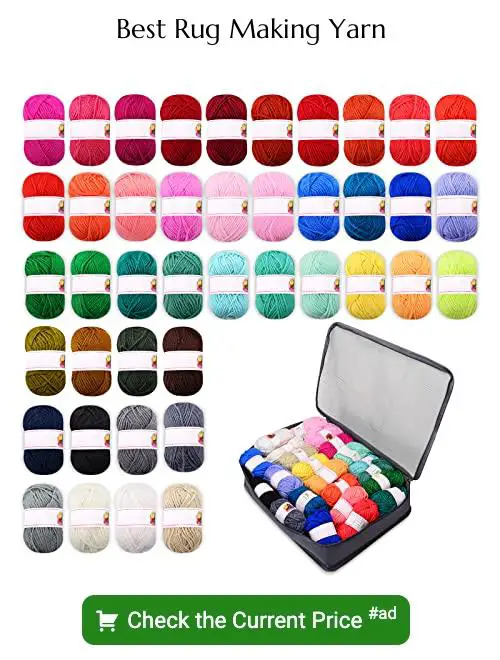Discover the various types of yarn perfect for creating stunning and durable rugs, as we delve into their unique characteristics and benefits in this insightful blog post.
Are you looking to make a cozy and stylish rug for your home? Choosing the right yarn is key to achieving the perfect texture, durability, and look. With so many options out there, it can be overwhelming to decide which type of yarn is best suited for your project.
That’s why we’re here to help! In this article, we’ll explore the different types of yarn that are ideal for making rugs. Whether you’re a seasoned crafter or just starting out, you’ll find valuable information on what yarns will work best for your rug-making needs.
So grab your hook or needles and let’s get started!
Natural Fiber Yarns
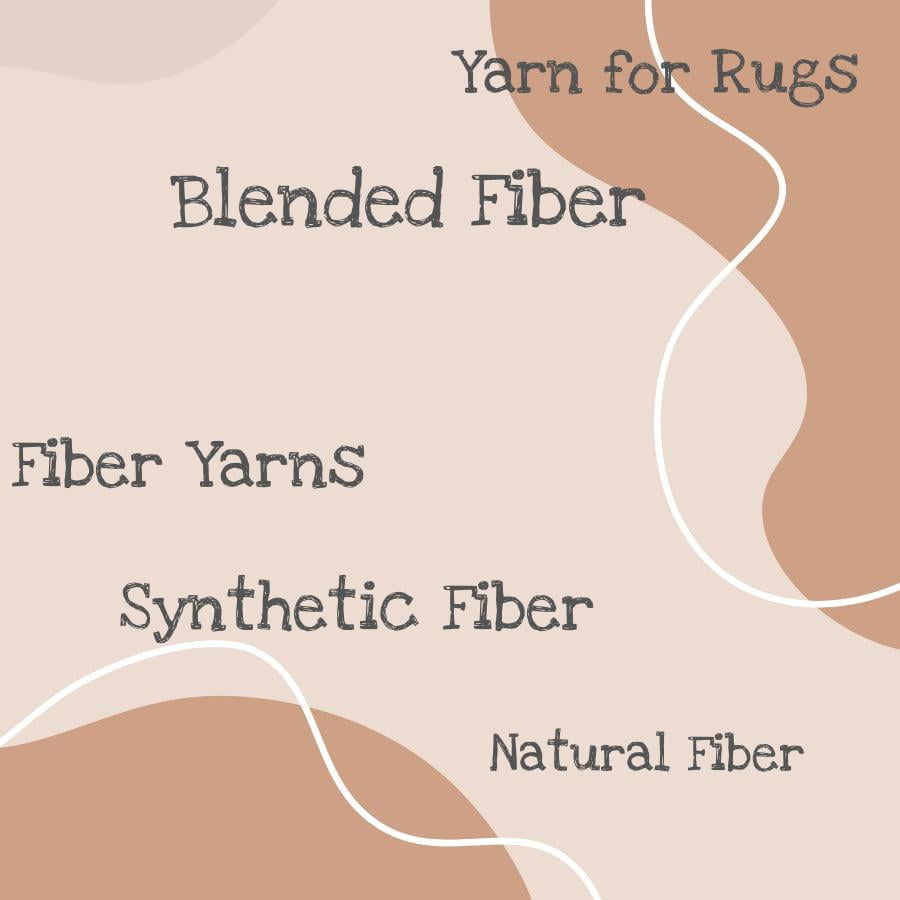
Cotton is one of the most commonly used natural fibers in yarn production. It’s easy to work with and comes in a variety of colors, making it perfect for creating intricate designs or simple patterns.
Wool is another popular natural fiber that’s great for rugs because it’s naturally flame-resistant and insulating. Wool also has excellent moisture-wicking properties which make it ideal for high-traffic areas like entryways or living rooms.
Jute is a sturdy plant-based fiber that adds texture to any rug project. It has an earthy look that complements rustic decor styles perfectly.
Cotton

It’s also easy to care for and comes in a wide range of colors. Cotton yarns are perfect for creating lightweight rugs that are ideal for warmer climates or high-traffic areas.
One of the benefits of using cotton yarns is their ability to hold up well over time without losing their shape or color. They’re also machine washable, making them an excellent option if you’re looking for low-maintenance rugs that can withstand frequent use.
When choosing cotton yarns, consider the weight and thickness as they will affect the texture and drape of your finished rug. Thicker cotton yarns like Lion Brand 24/7 Cotton Yarn work best when creating chunky textured rugs while thinner options such as Lily Sugar ‘n Cream Solids & Denim Yarn create smoother finishes.
Wool
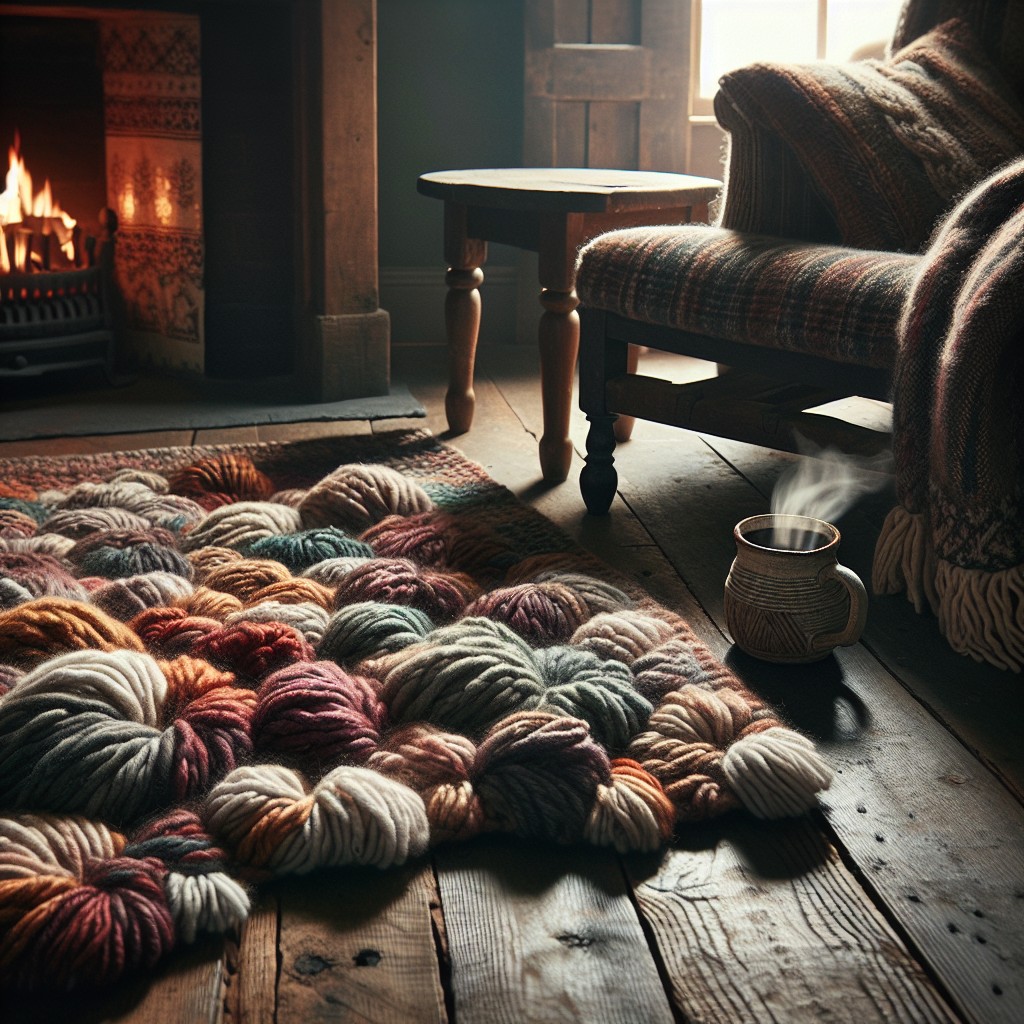
It’s also incredibly soft, making it perfect for cozy rugs that you can sink your toes into. Wool yarns come in various weights, from bulky to fingering weight, allowing you to create different textures and thicknesses in your rug.
One of the benefits of wool yarn is that it’s naturally flame-resistant and water-repellent. This makes wool rugs ideal for high-traffic areas like entryways or living rooms where spills are likely to occur.
When choosing wool yarns for your rug project, consider the breed of sheep the wool comes from as this will affect its texture and quality. Merino sheep produce fine fibers with excellent elasticity while Romney sheep have coarser fibers with less elasticity but more durability.
Jute
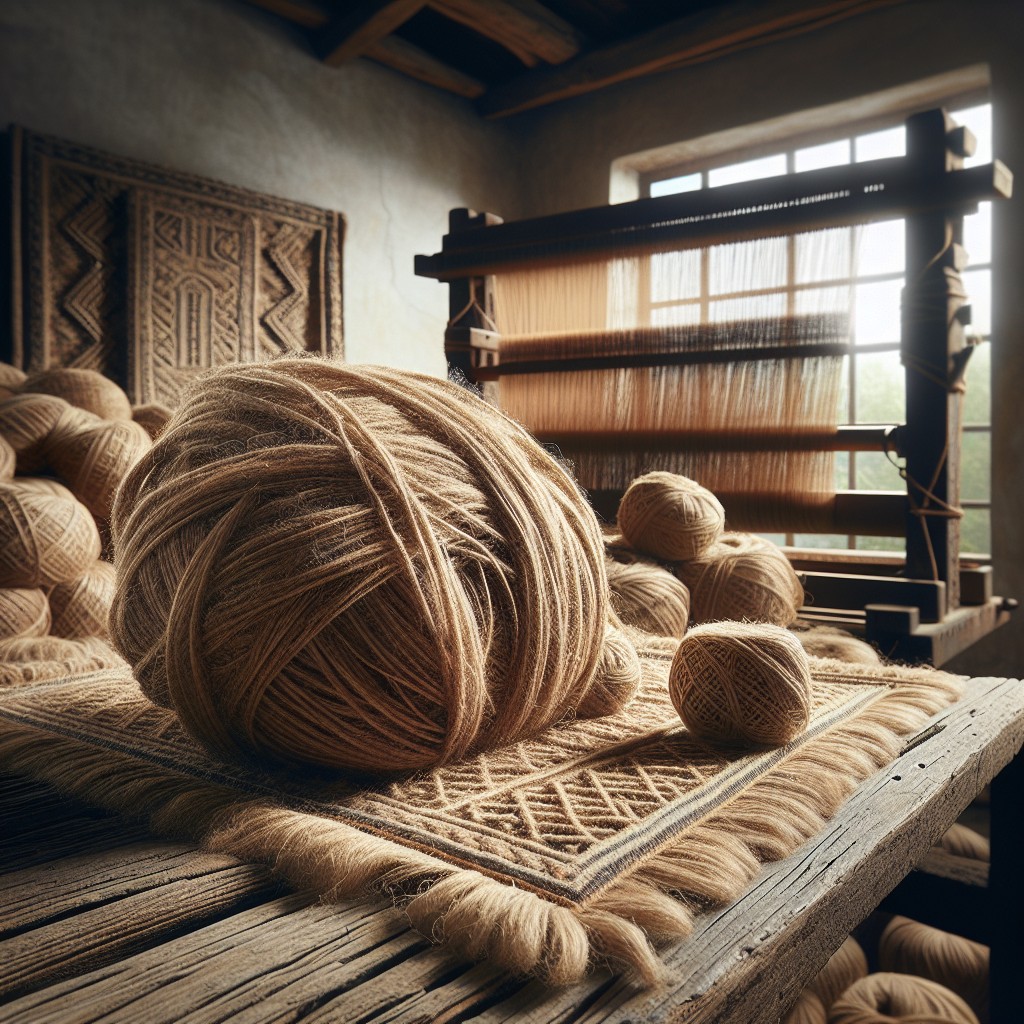
It’s an eco-friendly option as it’s biodegradable and renewable, making it perfect for those who want to create sustainable home decor. Jute yarns are known for their strength and durability, which makes them ideal for high-traffic areas in your home.
One of the benefits of using jute yarn is its affordability compared to other natural fibers like wool or cotton. However, keep in mind that jute can be rough on the skin due to its coarse texture, so you may want to use a softer material alongside it if you’re creating something meant for direct contact with skin.
When working with jute yarns, keep in mind that they tend to shed more than other fibers during the crocheting or knitting process. To minimize shedding while still achieving a beautiful finished product, consider using larger hooks or needles when working with this type of yarn.
Synthetic Fiber Yarns
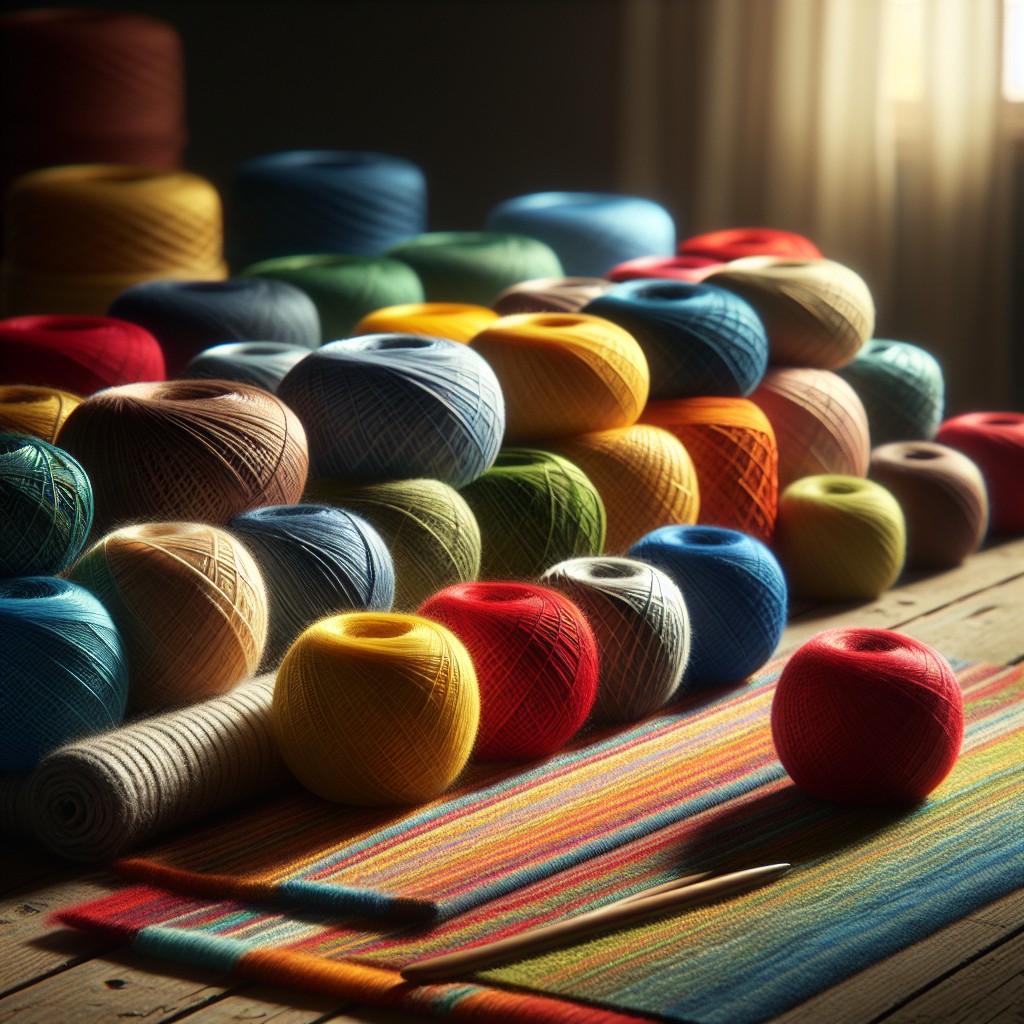
They are often less expensive than natural fiber yarns and come in a wide range of colors and textures. Acrylic is one of the most commonly used synthetic fibers for rug-making due to its durability, softness, and affordability.
It’s also easy to care for as it can be machine washed without losing its shape or color.
Polyester is another synthetic fiber that works well for rugs because it’s strong, lightweight, and resistant to stains. Nylon is also a good choice as it has excellent abrasion resistance which makes it ideal if you plan on placing your rug in high traffic areas.
While synthetic fibers may not have the same luxurious feel as natural fibers like wool or cotton, they do offer their own unique benefits when used in rug-making projects such as being more affordable while still providing durability and versatility with color options.
Acrylic
It’s made from synthetic fibers that are lightweight and soft to the touch. Acrylic yarns come in a wide range of colors and textures, making it easy to find the perfect match for your project.
One advantage of using acrylic yarn is that it’s machine washable and dryable, which makes cleaning your rug hassle-free. Acrylic fibers are resistant to fading from sunlight exposure or washing with harsh detergents.
When working with acrylic yarns for rugs or other projects requiring heavy use or foot traffic such as blankets or pillows; choosing an anti-pilling variety can help prevent unsightly fuzz balls on the surface over time.
Polyester
It’s an excellent choice for rug-making because it can withstand heavy foot traffic and is resistant to stains and fading. Polyester yarns are also available in a wide range of colors, making it easy to find the perfect shade for your project.
One of the benefits of using polyester yarns for rugs is that they’re often machine washable, which makes them easy to care for. They’re also lightweight compared to natural fibers like wool or cotton, so they won’t add unnecessary bulk or weight to your finished product.
When choosing polyester yarns for rug-making projects, look out for those labeled as “bulky” or “chunky.” These thicker strands will create a plush texture that’s perfect underfoot while still being durable enough not to mat down over time.
Nylon
It’s also easy to clean, making it an excellent choice for high-traffic areas or homes with pets. Nylon yarns come in a variety of colors, so you can find the perfect shade for your project.
One thing to keep in mind when working with nylon yarns is that they tend to be slippery, which can make them difficult to work with at times. However, this slipperiness also makes them ideal for creating shaggy rugs or other textured designs.
If you’re looking for a durable and versatile yarn option that will stand up well over time, nylon may be the right choice for your next rug-making project.
Blended Fiber Yarns
They offer the best of both worlds, combining the durability and strength of synthetic fibers with the softness and warmth of natural fibers. Blends can be made up in any ratio, depending on what qualities you want to emphasize.
One popular blended yarn for rug-making is wool-acrylic blend yarn. This type of blend combines wool’s insulating properties with acrylic’s durability, making it perfect for high-traffic areas like entryways or living rooms.
Another great option is cotton-polyester blends that provide excellent absorbency while also being easy to care for. These blends are ideal if you’re looking to make a kitchen or bathroom rug that can withstand frequent washing.
Specific Yarn Brands
Here are some of our top picks:.
– Lion Brand Mandala Thick & Quick: This super bulky yarn is made from 100% acrylic and comes in a range of beautiful colorways that will add a pop of color to any room.
– Red Heart Hygge: Made from a blend of acrylic and nylon, this cozy yarn has an ultra-plush feel that’s perfect for creating soft rugs.
– Billow: This chunky cotton yarn is incredibly soft and easy to work with. It’s available in several neutral shades that will complement any decor style.
– Lion Brand Wool Ease Thick & Quick: If you’re looking for warmth and durability, this wool-blend yarn is an excellent choice. It comes in over 50 colors so you’ll have plenty of options to choose from!
– Swish Bulky: Another wool-blend option, Swish Bulky offers great stitch definition while still being machine washable – making it ideal for high traffic areas like entryways or living rooms.
– Biggo Yarn from We Crochet: Made with superwash merino wool, this bulky weight yarn creates thick rugs with incredible texture. Plus it’s machine washable!
-Bernat Maker Home Dec : A tubular cord-like fiber which gives projects structure without sacrificing comfortability.
Lion Brand Mandala Thick & Quick
This super bulky weight yarn is made of 100% acrylic fiber, which makes it soft, durable, and easy to care for. It comes in a range of beautiful colorways that are sure to add some personality to your rug project.
One great thing about Lion Brand Mandala Thick & Quick is its thickness – it works up quickly so you can finish your rug in no time! The recommended hook size for this yarn is N-13 (9mm), but you can also use knitting needles if preferred.
If you’re looking for inspiration on how to use this fabulous yarn, check out the Lion Brand website or social media pages where they share patterns specifically designed with their products in mind. Whether you want something simple or intricate, there’s sure to be a pattern that catches your eye!
Lion Brand Mandala Thick & Quick offers both beauty and functionality when creating rugs.
Red Heart Hygge
This yarn is made of 70% acrylic and 30% nylon, which makes it durable yet comfortable to the touch. The unique texture of Red Heart Hygge creates a plush feel that’s perfect for snuggling up on your rug during cold winter nights.
One great thing about this yarn is its versatility in terms of color options. With over twenty different shades available, you’re sure to find the right hue to match your home decor or personal style.
Another advantage of using Red Heart Hygge for rug-making projects is its ease-of-care factor. It can be machine washed and dried without losing its shape or softness, making it ideal for high-traffic areas like living rooms or bedrooms.
Billow
Made from 100% unspun roving wool, this yarn has a unique texture that adds depth and dimension to your rug projects. Billow comes in an array of beautiful colors ranging from neutrals to brights, making it easy to find the perfect shade for your home decor.
One of the standout features of Billow is its thickness which makes it ideal for creating plush rugs with excellent insulation properties. The thick strands also make crocheting or knitting with this yarn quick and easy as you can cover more ground in less time.
When working with Billow, keep in mind that because it’s made from unspun wool fibers; there may be some shedding during use or washing. However, once woven into a rug project and given proper care instructions such as handwashing or dry cleaning only – you’ll have yourself an incredibly durable piece that will last years!
Lion Brand Wool Ease Thick & Quick
This yarn is made of 80% acrylic and 20% wool, making it both soft and durable. It comes in a variety of colors, from neutrals to brights, so you can find the perfect shade for your project.
One great thing about Lion Brand Wool Ease Thick & Quick is that it’s machine washable and dryable. This makes caring for your finished rug easy – simply toss it in the washing machine when needed! Plus, with its bulky weight (6), this yarn works up quickly so you can finish your project faster.
Swish Bulky
Made from 100% superwash merino wool, this bulky weight yarn is soft to the touch and easy to care for. It comes in a wide range of colors, so you can choose the perfect shade to match your home decor.
One of the best things about Swish Bulky is its durability. This yarn has been treated with a special process that makes it resistant to shrinking or felting when washed in hot water or put in the dryer on low heat.
That means you can use your rug without worrying about it losing its shape or texture over time.
Another great feature of Swish Bulky is how quickly it works up into finished projects due to its bulkiness – meaning less time spent crocheting! With just one skein, you can create an impressive-sized rug that will add warmth and comfort underfoot while also being visually appealing.
Biggo Yarn From We Crochet
Made of 50% superwash merino wool and 50% nylon, this yarn is durable, easy to care for, and comes in a range of beautiful colors. The blend of fibers gives the finished rug a lovely drape while still maintaining its shape over time.
One great thing about Biggo Yarn is that it works up quickly due to its bulky weight. This means you can create your rug in no time at all! Plus, with so many color options available – from brights to neutrals – you’re sure to find the perfect shade for your home decor.
Bernat Maker Home Dec
This yarn is made of 72% cotton and 28% nylon, making it durable and easy to care for. It comes in a wide range of colors, allowing you to choose the perfect shade for your project.
One great thing about Bernat Maker Home Dec is its thickness; it’s classified as super bulky (6) weight which means that your rug will work up quickly with this yarn. The texture of the finished product has an interesting woven look due to its unique construction – there are two strands twisted together giving it an almost rope-like appearance.
Another advantage of using Bernat Maker Home Dec for rugs is that it’s machine washable and dryable on low heat settings, making cleaning hassle-free! Plus, since this type of yarn can be found at most craft stores or online retailers like Amazon or Joann Fabric & Craft Stores – availability isn’t usually an issue either!.
T-Shirt Yarn
It’s made from recycled t-shirts and is perfect for creating eco-friendly rugs. T-shirt yarn comes in a variety of colors, patterns, and textures, making it easy to find the perfect match for your project.
One benefit of using t-shirt yarn for rug-making is its durability. The material used to make t-shirts is typically strong enough to withstand wear and tear over time, which means your rug will last longer than those made with other types of yarn.
Another advantage of using this type of yarn is its affordability. Since it’s made from recycled materials, you can often find it at a lower cost than traditional fibers like wool or cotton.
When working with t-shirt yarn, keep in mind that the texture may be different from what you’re used to when working with other types of fibers. It can also be thicker or thinner depending on how tightly the fabric was spun into the “yarn”.
Factors to Consider When Choosing Yarn
First and foremost is the ease of care. Will your rug be in a high-traffic area that requires frequent cleaning? If so, you’ll want a yarn that can withstand regular washing without losing its shape or color.
Another important factor is fiber content. Natural fibers like cotton and wool are great for rugs because they’re durable and absorbent, but they may not be as budget-friendly as synthetic options like acrylic or polyester.
Yarn cost is also something to keep in mind when selecting materials for your project. Some specialty yarns can be quite expensive, while others offer more affordable alternatives without sacrificing quality.
Availability of certain types of yarn may also play a role in your decision-making process if you have limited access to local craft stores or prefer specific brands not readily available near you.
Lastly, color options should also factor into which type of yarn you choose since different fibers take dye differently resulting in varying shades even with similar colors across different brands. By considering these factors carefully before making any purchases will help ensure that the finished product meets all expectations while staying within budget constraints!
Ease of Care
After all, rugs are meant to be walked on and used daily! Natural fiber yarns like wool and cotton can require more delicate washing methods than synthetic fibers like acrylic or polyester. However, natural fibers tend to be more durable in the long run.
If you’re looking for an easy-care option that still has the look of natural fiber yarns, consider blended options such as wool/acrylic blends or cotton/polyester blends. These types of yarns offer the best of both worlds: durability and ease-of-care.
Fiber Content
Different fibers have unique characteristics that affect the durability, texture, and overall look of your finished project.
Natural Fiber Yarns: Cotton: This soft and breathable fiber is perfect for creating lightweight rugs that are easy to care for. Wool: Wool yarns are known for their warmth and durability.
They’re great at retaining heat making them ideal in colder climates. Jute: Jute has a rougher texture than cotton or wool but creates beautiful natural-looking rugs with a rustic feel.
Synthetic Fiber Yarns: Acrylic: Acrylic yarn is affordable, durable, and available in many colors making it popular among crafters. It’s also machine washable which makes cleaning up spills easier.
Polyester & Nylon – These synthetic fibers create strong yet lightweight rugs that can withstand heavy foot traffic without showing wear-and-tear easily.
Blended Fiber Yarns: Blending different types of fibers together can result in unique textures while still maintaining strength. For example combining wool with acrylic results in warm yet affordable options like Lion Brand Wool Ease Thick & Quick or Swish Bulky from We Crochet.
Yarn Cost
Yarn prices can vary greatly depending on the fiber content, brand, and weight of the yarn. Natural fibers like wool and jute tend to be more expensive than synthetic fibers like acrylic or polyester.
However, keep in mind that investing in higher quality yarn may save you money in the long run as it will create a durable rug that lasts longer. Some brands offer affordable options without sacrificing quality.
Consider your budget when selecting a type of yarn for your project but don’t let price be the only deciding factor. Take into account other factors such as ease of care and availability before making a final decision on which type of yarn is best suited for your needs.
Yarn Availability
Some types of yarn may be more readily available in certain areas or stores than others. For example, natural fiber yarns like wool and jute may be easier to find at specialty craft stores or online retailers compared to synthetic fibers like acrylic and polyester which are often found in big-box stores.
It’s also worth noting that some specific brands of yarn may only be available through certain retailers or websites. If you have a particular brand in mind for your rug project, it’s a good idea to do some research beforehand on where you can purchase it.
If you’re having trouble finding the type of yarn you need locally, don’t worry! Many online retailers offer a wide variety of options with convenient shipping straight to your door. Just make sure that if ordering online, take into account any additional costs such as shipping fees and delivery times when planning out your project timeline.
Color Options
The right color can enhance the overall look and feel of your space, while a poor choice can clash with existing decor or make a room feel unbalanced. Luckily, there are countless options available when it comes to selecting colors for your rug.
Many natural fiber yarns come in earthy tones such as beige, brown and green which work well in rustic or bohemian style homes. Woolen yarns offer rich jewel tones that add depth and warmth to any room they’re used in.
Synthetic fibers like acrylic often have bright hues that are perfect for modern spaces where you want pops of bold colors throughout the home. Polyester also offers vibrant shades but has more sheen than acrylic making them ideal if you want some shine on your rugs.
Blended fiber yarns combine different materials resulting in unique textures and finishes which makes them great choices if you’re looking for something out-of-the-box.
Common Rug Yarn Questions
Here are some common queries that may come up:.
- What is the most durable yarn for a rug?
- Can I use any type of yarn to make a rug?
- How much yardage do I need for my desired size of rug?
- Should I choose thick or thin yarns for my project?
- Are there any specific care instructions when washing rugs made from certain types of fibers?
These are just a few examples, but don’t worry – we’ll cover all these topics and more in this article.
FAQ
What yarn is best for rug tufting?
The best yarn for rug tufting is wool, cotton, or acrylic yarn, with acrylic being the least expensive and widely available option.
Can you use acrylic yarn for rugs?
Answer: Yes, you can use acrylic yarn for rugs, but it may not be suitable for heavy foot-traffic areas due to pilling.
Can you use regular yarn for rug making?
Yes, you can use regular yarn for rug making, particularly worsted weight-bulky yarns that are not slippery, with wool being an excellent choice and other non-slippery fibers also being suitable.
What are the most durable yarn materials for creating long-lasting rugs?
Answer: The most durable yarn materials for creating long-lasting rugs include wool, nylon, and polypropylene.
How does the yarn thickness affect the overall quality and feel of a finished rug?
The yarn thickness affects the overall quality and feel of a finished rug by influencing its durability, softness, and texture.
Are there any eco-friendly yarn options suitable for rug making?
Yes, there are eco-friendly yarn options suitable for rug making, such as natural fibers like cotton, jute, and wool.
